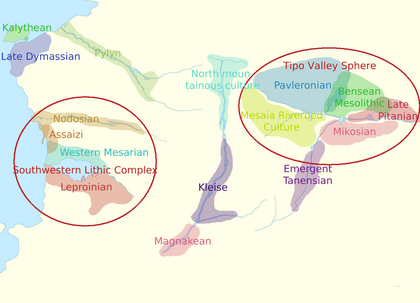Mesolithic Moellia (Pacifica): Difference between revisions
No edit summary |
No edit summary |
||
| Line 1: | Line 1: | ||
[[File:Rhayna mesolithic cultures.png|thumb|420x420px|Map of the general areas of the mesolithic cultures of Moellia in 12,000 BCE]] | |||
'''Mesolithic Moellia''', or '''Mesolithic Rhayna''', encompasses the mesolithic in the [[Moellia (Pacifica)|Moellia]] region from the end of the Last Glaciation Period Peak 22,000 years ago, to the end of the Last Glacial Period in Moellia and the Neolithic Revolution in the current state of [[Rhayna state (Pacifica)|Rhayna]] in 11,700 BCE. | '''Mesolithic Moellia''', or '''Mesolithic Rhayna''', encompasses the mesolithic in the [[Moellia (Pacifica)|Moellia]] region from the end of the Last Glaciation Period Peak 22,000 years ago, to the end of the Last Glacial Period in Moellia and the Neolithic Revolution in the current state of [[Rhayna state (Pacifica)|Rhayna]] in 11,700 BCE. | ||
The mesolithic in Moellia is characterized by the massive retreat of human groups from the interior of the region to the increasingly bigger rivers and the basin of Lake Kryo, due to the raising temperatures and change of climate as the region enters into the Holocene interglacial period. It is theorized that the pressure of the raising population density, scarcity of vegetation and retreat of large mammals to the south out of the region triggered the development of microlithic technology, proto-cultures, and a change of life-style into hunter-gatherers. | The mesolithic in Moellia is characterized by the massive retreat of human groups from the interior of the region to the increasingly bigger rivers and the basin of Lake Kryo, due to the raising temperatures and change of climate as the region enters into the Holocene interglacial period. It is theorized that the pressure of the raising population density, scarcity of vegetation and retreat of large mammals to the south out of the region triggered the development of microlithic technology, proto-cultures, and a change of life-style into hunter-gatherers. | ||
Most mesolithic sites are found near water sources, although with a farther range than zones nowadays deserted, and although some of them present signs of pottery and textiles in the middle of the mesolithic, specially in the Southwestern Lithic Complex and the Tipo Valley Sphere, most settlements do not develop these technologies until the end of the mesolithic and the start of the Neolithic Revolution. | |||
Revision as of 18:42, 18 January 2024

Mesolithic Moellia, or Mesolithic Rhayna, encompasses the mesolithic in the Moellia region from the end of the Last Glaciation Period Peak 22,000 years ago, to the end of the Last Glacial Period in Moellia and the Neolithic Revolution in the current state of Rhayna in 11,700 BCE.
The mesolithic in Moellia is characterized by the massive retreat of human groups from the interior of the region to the increasingly bigger rivers and the basin of Lake Kryo, due to the raising temperatures and change of climate as the region enters into the Holocene interglacial period. It is theorized that the pressure of the raising population density, scarcity of vegetation and retreat of large mammals to the south out of the region triggered the development of microlithic technology, proto-cultures, and a change of life-style into hunter-gatherers.
Most mesolithic sites are found near water sources, although with a farther range than zones nowadays deserted, and although some of them present signs of pottery and textiles in the middle of the mesolithic, specially in the Southwestern Lithic Complex and the Tipo Valley Sphere, most settlements do not develop these technologies until the end of the mesolithic and the start of the Neolithic Revolution.